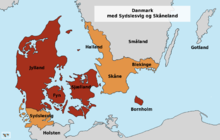
Back شليسفيك الجنوبية Arabic De Schleswig Welsh Sydslesvig Danish Südschleswig German Schleswig Meridional Spanish Lõuna-Schleswig Estonian شلسویگ جنوبی Persian Schleswig du Sud French Schleswig Selatan ID Schleswig meridionale Italian




Southern Schleswig (German: Südschleswig or Landesteil Schleswig, Danish: Sydslesvig; North Frisian: Söödslaswik) is the southern half of the former Duchy of Schleswig[1] in Germany on the Jutland Peninsula. The geographical area today covers the large area between the Eider river in the south and the Flensburg Fjord in the north,[2] where it borders Denmark. Northern Schleswig, congruent with the former South Jutland County, forms the southernmost part of Denmark. The area belonged to the Crown of Denmark until Prussia and Austria declared war on Denmark in 1864. Denmark wanted to give away the German-speaking Holsten and set the new border at the small river Ejderen. Prussian chancellor Otto von Bismarck concluded that this justified a war, and even proclaimed it a "holy war". He also turned to the Emperor of Austria, Franz Joseph I of Austria for help. A similar war in 1848 had gone poorly for the Prussians. With Prussia's modern weapons and the help from both the Austrians and General Moltke, the Danish army was destroyed and forced to make a disorderly retreat. The Prussian-Danish border was then moved from the Elbe up in Jutland to the Kongeåen creek.
After the First World War, two referendums decided a new border.[3][4] The northern part reverted to Denmark as Nordslesvig (North Slesvig). But the middle and southern part, including Schleswig's only city, Flensburg, remained in what since the unification of Germany had become German hands. In Denmark, the loss of Flensborg caused a political crisis, Påskekrisen or the Easter Crisis, as it happened during the Easter of 1920.[5][6] After the Second World War the area remained as German territory and, with Holstein, formed the new state of Schleswig-Holstein as a part of the Federal Republic of Germany (West Germany) in 1948.
- ^ Kathrin Sinner: Schleswig-Holstein - das nördliche Bundesland: Räumliche Verortung als kulturelles Identitäskonstruk, page 86
- ^ Sønderjylland A-Å, Aabenraa 2011, page 364
- ^ 103982@au.dk (13 April 2018). "Vis". danmarkshistorien.dk.
{{cite web}}: CS1 maint: numeric names: authors list (link) - ^ German, Troels Fink: "Geschichte des schleswigschen Grenzlandes" Publisher: Munksgaard, Copenhagen 1958, pages 178-192.
- ^ "Påskekrisen 1920: HISTORIEFAGET". Archived from the original on 2016-05-07. Retrieved 2016-04-08.
- ^ "Påskekrisen 1920 - Gyldendal - Den Store Danske". denstoredanske.dk.